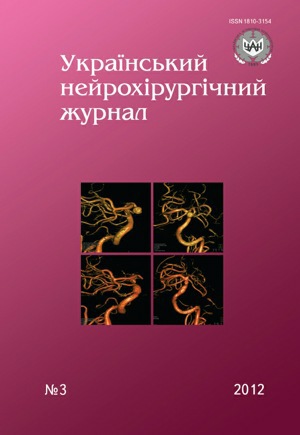Microdiscectomy combined with interspinous fixation system at multifactor compression of lumbar spine
DOI:
https://doi.org/10.25305/unj.60842Keywords:
lumbar spinal stenosis, microdiscectomy, systems of interspinous fixationAbstract
The purpose: to evaluate surgical treatment of intravertebral discs hernias, combined with spine stenosis on the level of appropriate spinal-moving segment (SMS) of lumbar spine.
Materials and methods. The results of surgical treatment of 49 patients with multifactor compression (intravertebral disc hernias in combination with stenosis of appropriate SMS). Surgical treatment tactics provided simultaneous elimination of compression and lumbar SMS stenosis with subsequent installation of interspinous fixation systems.
Results. After surgical treatment SMS biomechanics did not changed significantly. Considerable improvement of quality of life of patients was noticed.
Conclusions. Dynamic interspinous implants (Coflex and DIAM) application at microdiscectomies performing in patients with multifactor compression allowed to improve treatment results considerably.
References
1. Herrera Herrera I, Moreno de la Presa R, González Gutiérrez R, Bárcena Ruiz E, García Benassi JM. Evaluation of the postoperative lumbar spine. Radiologia. 2013 Jan-Feb;55(1):12-23. Epub 2012 Apr 19. Review. English, Spanish. [CrossRef] [PubMed]
2. Slipman C, Shin C, Patel R et al. Etiologies of Failed Back Surgery Syndrome. Pain Medicine. 2002;3(3):200-214. [CrossRef] [PubMed]
3. Fritsch E, Heisel J, Rupp S. The Failed Back Surgery Syndrome. Spine. 1996;21(5):626-633. [CrossRef] [PubMed]
4. Chun-jing H, Hao-xiong N, jia-xiang N. The application of percutaneous lysis of epidural adhesions in patients with failed back surgery syndrome. Acta Cirurgica Brasileira. 2012;27(4):357-362. [CrossRef] [PubMed]
5. Trescot AM, Chopra P, Abdi S, Datta S, Schultz DM. Systematic review of effectiveness and complications of adhesiolysis in the management of chronic spinal pain: an update. Pain Physician. 2007;10(1):129-146. [PubMed]
6. Rodrigues F, Dozza D, Oliveira C, Castro R. Failed back surgery syndrome: casuistic and etiology. Arq Neuro-Psiquiatr. 2006;64(3b):757-761. [CrossRef] [PubMed]
7. Manchikanti L, Manchukonda R, Pampati V, Damron K, McManus C. Prevalence of Facet Joint Pain in Chronic Low Back Pain in Postsurgical Patients by Controlled Comparative Local Anesthetic Blocks.Archives of Physical Medicine and Rehabilitation. 2007;88(4):449-455. [CrossRef] [PubMed]
8. Zozulya YUA, Pedachenko Ye G, Slynko Ye I. Khirurgicheskiye vmeshatelstva pri stenoze poyasnichnogo otdela pozvonochnika Khirurgicheskoye lecheniye neyrokompressionnykh poyasnichno-kresttsovykh bolevykh sindromov. Kiev: UIPK «YeksOb»; 2006. Russian.
9. Kuklo T, Potter B, Ludwig S. Treatment of lumbar spinal stenosis. Spine. 2006;31:1047–1055.
10. Tuite GE, Stern JD, Doran SE. [et al.]. Outcome after laminectomy for spinal stenosis. Part I. Clinical correlations. J. Neurosurg. 1995;82:912–918.
11. Verbiest H. Results of surgical treatment of idiopathic developmental stenosis of the vertebral canal. A review of 27 years experience. J. Bone Joint Surg. Br. 1977;59:181–188.
12. Samani J. Study of a semi-rigid interspinous “U”-fixation system. Orthop. Surg. 2000;28:348–353.
13. Zucherman JF, Hsu KY, Hartjen CA, Mehalic TF, Implicito DA, Martin MJ, Johnson DR 2nd, Skidmore GA, Vessa PP, Dwyer JW, Puccio S, Cauthen JC, Ozuna RM. A prospective randomized multi-center study for the treatment of lumbar spinal stenosis with the X STOP interspinous implant: 1-year results. Eur Spine J. 2004;13(1):22-31. [PubMed]
Downloads
Published
How to Cite
Issue
Section
License
Copyright (c) 2012 Mykhaylo Khyzhnyak, Yuriy Pedachenko, Aleksandr Tanaseychuk, Volodymyr Kramarenko

This work is licensed under a Creative Commons Attribution 4.0 International License.
Ukrainian Neurosurgical Journal abides by the CREATIVE COMMONS copyright rights and permissions for open access journals.
Authors, who are published in this Journal, agree to the following conditions:
1. The authors reserve the right to authorship of the work and pass the first publication right of this work to the Journal under the terms of Creative Commons Attribution License, which allows others to freely distribute the published research with the obligatory reference to the authors of the original work and the first publication of the work in this Journal.
2. The authors have the right to conclude separate supplement agreements that relate to non-exclusive work distribution in the form of which it has been published by the Journal (for example, to upload the work to the online storage of the Journal or publish it as part of a monograph), provided that the reference to the first publication of the work in this Journal is included.









